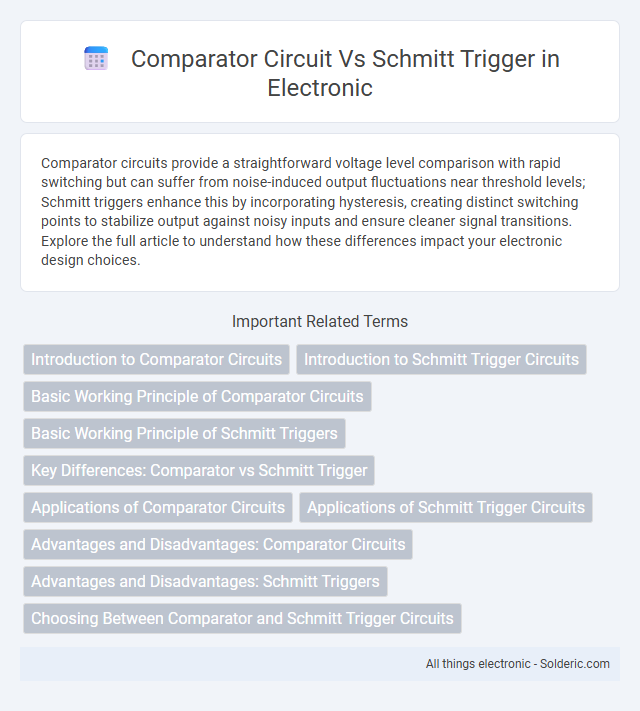Comparator circuits provide a straightforward voltage level comparison with rapid switching but can suffer from noise-induced output fluctuations near threshold levels; Schmitt triggers enhance this by incorporating hysteresis, creating distinct switching points to stabilize output against noisy inputs and ensure cleaner signal transitions. Explore the full article to understand how these differences impact your electronic design choices.
Comparison Table
| Feature | Comparator Circuit | Schmitt Trigger |
|---|---|---|
| Basic Function | Compares two voltages and outputs a high or low signal | Comparator with hysteresis to eliminate noise and provide stable switching |
| Output Behavior | Switches output at a single threshold voltage | Switches output between two threshold voltages (upper and lower) |
| Hysteresis | None or minimal, sensitive to input noise | Built-in hysteresis to reduce noise and false triggering |
| Applications | Zero-crossing detection, level detection | Signal conditioning, waveform shaping, debounce circuits |
| Noise Immunity | Low, prone to output chatter with noisy input | High, stable switching in noisy environments |
| Complexity | Simple design | More complex due to feedback for hysteresis |
| Example ICs | LM311, LM339 | 74HC14 (inverter-based), TLV1701 |
Introduction to Comparator Circuits
A comparator circuit compares two voltages and outputs a digital signal indicating which input is higher, serving as a fundamental component in analog-to-digital conversion and signal detection. Unlike a Schmitt trigger, which incorporates hysteresis to provide noise immunity and clean switching, a basic comparator operates without feedback, leading to potential output fluctuations near the threshold. Understanding the role of comparators helps you design precise and efficient circuits for threshold detection and waveform shaping.
Introduction to Schmitt Trigger Circuits
Schmitt trigger circuits feature hysteresis, providing noise immunity and stable output transitions in noisy environments, unlike standard comparator circuits that switch output as the input crosses a single threshold. These circuits are widely used in signal conditioning, waveform shaping, and debouncing switches due to their ability to prevent false triggering. The input voltage must cross distinct upper and lower threshold levels before the output switches states, creating a controlled output response with reduced sensitivity to small input fluctuations.
Basic Working Principle of Comparator Circuits
Comparator circuits operate by comparing two input voltages and outputting a digital signal indicating which input is higher, using an operational amplifier without feedback to amplify the voltage difference rapidly. Schmitt triggers, a type of comparator with hysteresis, add feedback to provide stable switching and noise immunity by defining two distinct threshold voltages for rising and falling signals. Your choice between these components depends on whether you need simple voltage comparison or noise-resistant signal conditioning.
Basic Working Principle of Schmitt Triggers
A Schmitt trigger is a comparator circuit with hysteresis designed to provide stable output switching by introducing two distinct threshold voltage levels: one for transitioning from low to high and another for high to low. This hysteresis prevents noise-induced oscillations in the output signal, making Schmitt triggers ideal for cleaning up noisy input signals or creating stable digital signals from analog inputs. Your circuit benefits from Schmitt triggers in applications requiring clean, noise-immune switching behavior compared to standard comparator circuits.
Key Differences: Comparator vs Schmitt Trigger
Comparator circuits provide a binary output by comparing input voltage levels against a reference voltage with a fixed threshold, resulting in a sharp switching action ideal for precise signal detection. Schmitt triggers incorporate hysteresis through dual threshold voltages, preventing output oscillations and noise-induced false triggering in slowly varying or noisy input signals. The key difference lies in hysteresis presence: comparators lack it and are sensitive to noise, while Schmitt triggers ensure signal stability with defined upper and lower switching thresholds.
Applications of Comparator Circuits
Comparator circuits are extensively used in analog-to-digital converters (ADCs), zero-crossing detectors, and voltage level detectors to compare input voltages and provide binary outputs. They play a vital role in sensor interfacing, such as temperature monitoring and light sensing, where precise threshold detection is essential. Comparator circuits also enable waveform generation, pulse-width modulation (PWM) control, and over-voltage protection in power supply and control systems.
Applications of Schmitt Trigger Circuits
Schmitt trigger circuits are widely used in signal conditioning to convert noisy or analog input signals into clean digital outputs, making them essential in debouncing mechanical switches and shaping waveform distortions in communication systems. Their hysteresis characteristic prevents rapid switching noise by requiring different threshold voltages for rising and falling signals, ensuring stable transitions in sensor interfacing and oscillator circuits. Schmitt triggers improve system reliability in digital circuits by enhancing noise immunity and reducing false triggering, critical for timing applications and pulse generation.
Advantages and Disadvantages: Comparator Circuits
Comparator circuits offer fast response time and simple design, making them ideal for zero-crossing detection and signal level comparison in analog-to-digital conversion. However, they suffer from noise sensitivity and output instability without hysteresis, leading to multiple transitions in noisy environments. The lack of built-in hysteresis distinguishes them from Schmitt triggers, which provide noise immunity and clean switching by incorporating positive feedback.
Advantages and Disadvantages: Schmitt Triggers
Schmitt triggers offer superior noise immunity and provide well-defined switching thresholds, which prevent false triggering in noisy signals, making them ideal for signal conditioning and waveform shaping. Their main disadvantages include a slower response time compared to standard comparators and potentially increased power consumption due to hysteresis implementation. These characteristics make Schmitt triggers less suitable for high-speed applications but highly effective for stabilizing input signals in digital circuits.
Choosing Between Comparator and Schmitt Trigger Circuits
Choosing between comparator and Schmitt trigger circuits depends on the application's noise immunity and signal stability requirements. Comparator circuits excel at detecting voltage levels with sharp transitions but lack hysteresis, making them sensitive to noise and causing output fluctuations near threshold levels. Schmitt triggers incorporate hysteresis, providing stable switching behavior and improved noise rejection, ideal for noisy or slow-changing input signals.
comparator circuit vs schmitt trigger Infographic

 solderic.com
solderic.com